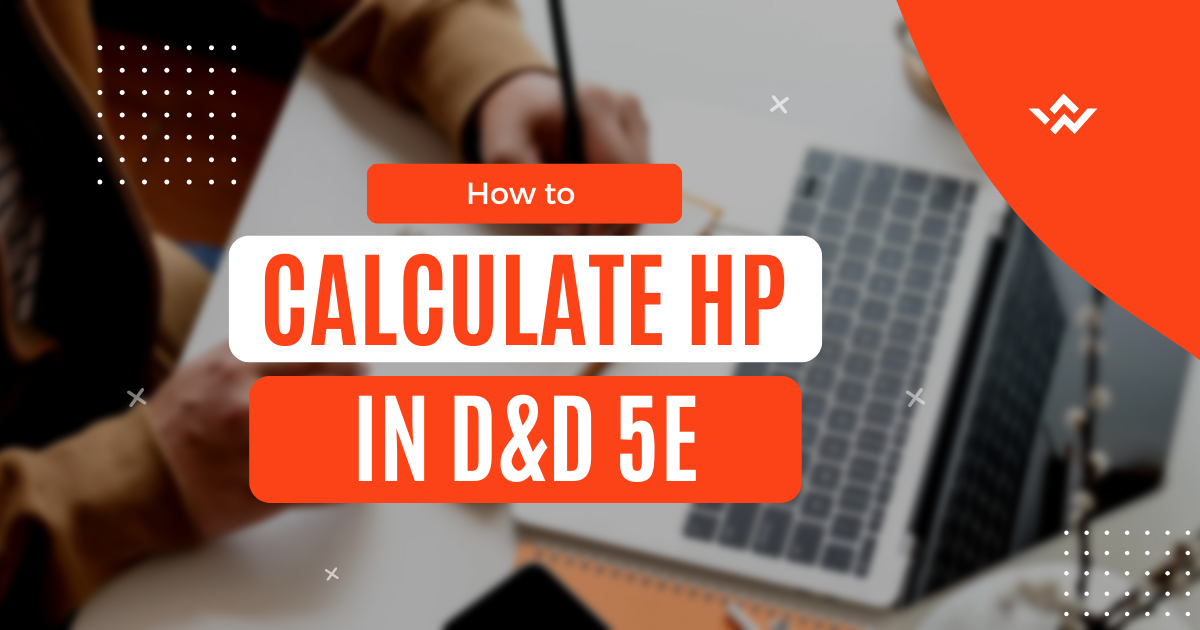Introduction: How to Calculate HP in D&D 5e
If you’re new to Dungeons & Dragons 5th Edition (D&D 5e), one of the first questions you’ll face is: how do I calculate hit points (HP)? Hit Points are the lifeblood of your character — they determine how much damage you can take before falling unconscious, and they directly influence your survival and combat effectiveness.
In this complete beginner’s guide, we’ll walk you through everything you need to know about calculating HP in D&D 5e — from basic formulas to advanced multiclass examples. Whether you’re wondering about rolled HP vs fixed HP, how Constitution affects your HP, or how racial traits and feats modify it, this guide has you covered.
And if math isn’t your thing? Don’t worry. You can always use this free HP calculator to make the process quick and error-free.
What Are Hit Points (HP) in D&D 5e?a
Hit Points (HP) are a numerical representation of your character’s health and durability in Dungeons & Dragons 5e. In simple terms, HP tells you how much punishment your adventurer can withstand before being knocked unconscious or killed.
Think of HP as a mix of physical stamina, toughness, luck, and sheer willpower. It’s not just about how hard you are to kill physically — it also reflects your character’s ability to dodge fatal blows, keep fighting while wounded, and endure magical or environmental damage.
Why HP Matters in the Game
In every D&D campaign, combat is inevitable. Whether you’re battling goblins in a dungeon or fending off a dragon’s fiery breath, HP is your survival line. If you miscalculate or underestimate your HP, your character might not live to see the next adventure.
For beginners, properly understanding HP ensures you can play confidently without worrying about unfair deaths. Dungeon Masters (DMs) also rely on accurate HP to balance encounters, so the mechanic is essential for smooth gameplay.
How HP Represents Your Character’s Survivability
HP isn’t just a static number — it scales as your character levels up. A Level 1 wizard with 8 HP will feel fragile compared to a Level 5 fighter with 45+ HP. The higher your HP, the more resilient you become, and the more you can contribute to your party without constant fear of falling unconscious.
Survivability also includes modifiers such as racial traits, Constitution bonuses, and special feats like Tough. All of these affect how your HP is calculated, and we’ll explore them in detail below.
Core Formula for Calculating HP in D&D 5e
At its core, calculating HP in D&D 5e comes down to three main components:
-
Hit Dice by Class
-
Constitution Modifier
-
Level Progression (how HP grows with each level)
Let’s break them down one by one.
Hit Dice by Class (d6, d8, d10, d12)
Every class in D&D 5e has an assigned Hit Die that determines its base HP growth.
-
d6 → Wizard, Sorcerer (fragile classes)
-
d8 → Cleric, Rogue, Bard, Druid (balanced classes)
-
d10 → Fighter, Paladin, Ranger (tough martial classes)
-
d12 → Barbarian (the tankiest class)
At Level 1, you start with the maximum value of your Hit Die (plus your Constitution modifier). For example, a Fighter starts with 10 + CON modifier HP at Level 1.
Constitution Modifier and Its Role in HP
Your Constitution (CON) score directly affects your HP. Every point of Constitution modifier is added to each Hit Die you roll or take for HP.
Example:
-
Constitution score of 16 = +3 modifier
-
Constitution score of 10 = +0 modifier
-
Constitution score of 8 = –1 modifier
This means a Barbarian with +3 CON gains +3 HP every level, while a frail Wizard with –1 CON will actually lose 1 HP per level (but cannot go below 1).
Level Progression and HP Growth
After Level 1, your HP increases each time you level up. You can either:
-
Roll your Hit Die and add CON modifier, or
-
Take the fixed average value and add CON modifier.
Over time, this scaling makes your character sturdier and more battle-ready.
Methods of Calculating HP in D&D 5e
Players can choose between two primary methods: rolled HP or fixed average HP. Both start with maximum HP at Level 1.
Max Hit Die at Level 1
At Level 1, every class begins with the maximum roll of their Hit Die + Constitution modifier. This ensures no player starts the game with dangerously low HP.
Example:
-
Level 1 Wizard (d6) with +2 CON → 6 + 2 = 8 HP
-
Level 1 Fighter (d10) with +3 CON → 10 + 3 = 13 HP
Average HP per Level (Fixed Method)
The fixed HP method gives you a reliable average instead of rolling. Each class has a standard value:
-
d6 → 4
-
d8 → 5
-
d10 → 6
-
d12 → 7
So if a Fighter with +3 CON chooses fixed HP, they gain 6 + 3 = 9 HP per level.
Rolled HP per Level (Random Method)
If you prefer risk and reward, you can roll your Hit Die each time you level up. This can result in high HP gains… or painfully low ones.
Example:
-
Level up Fighter (d10): you roll a 3 → 3 + 3 CON = 6 HP gained.
-
Next level, you roll a 9 → 9 + 3 = 12 HP gained.
Pros and Cons of Each Method
-
Fixed HP: Predictable, balanced, and beginner-friendly.
-
Rolled HP: Exciting, but risky. You could end up with weaker survivability if unlucky.
Most players stick to fixed HP for consistency, but some love the gamble of rolling.
Special Bonuses That Affect HP
Beyond the core formula, certain feats and racial traits can boost your HP further.
Tough Feat (+2 HP per level)
The Tough feat gives your character a flat +2 HP per level. This is incredibly powerful for front-line classes like Fighters, Paladins, or Barbarians.
At Level 10, that’s an extra +20 HP just from the feat.
Hill Dwarf Racial Bonus (+1 HP per level)
Hill Dwarves gain an additional +1 HP per level thanks to their racial trait Dwarven Toughness. This stacks with the Tough feat and Constitution modifiers.
A Hill Dwarf Barbarian with Tough can easily outlast most other characters.
Temporary HP vs Permanent HP
It’s important to note that Temporary HP (from spells like False Life or abilities like Heroism) is not permanent. It acts like a shield and disappears when depleted. Unlike permanent HP, it does not stack but instead replaces any existing temporary HP.
Multiclassing and Hit Points in D&D 5e
When you multiclass, you don’t just stack full hit dice. Instead, each class contributes its own Hit Die progression.
How to Split Levels Across Classes
For each level in a class, you roll or take the average for that class’s Hit Die, then add your Constitution modifier. You add them together to get your total HP.
Example: Fighter (3) + Wizard (2) HP Calculation
-
Fighter levels: 10 (max at level 1) + 2 × (6 average) = 22
-
Wizard levels: 2 × (4 average) = 8
-
Constitution modifier: Assume +2 → adds +10 across 5 levels
-
Total HP = 40
This ensures multiclass characters have balanced durability that reflects both classes.
Manual HP Calculation vs Online Calculator
While it’s important to understand how HP works, manual math can get messy, especially with multiclassing and feats involved.
Common Mistakes Players Make When Calculating HP
-
Forgetting to add Constitution modifier each level
-
Confusing temporary HP with permanent HP
-
Ignoring racial bonuses like Hill Dwarf toughness
-
Misapplying the Tough feat
Benefits of Using an Online D&D HP Calculator
To avoid errors, many players prefer to try our D&D 5e Hit Points Calculator. It automatically handles:
-
Class Hit Dice averages
-
Constitution modifiers
-
Feats and racial traits
-
Multiclass combinations
This saves time and ensures accuracy.
Example HP Calculations (Step-by-Step)
Let’s see some real examples to make this crystal clear.
Example 1: Level 5 Fighter with +3 CON
-
Level 1: 10 + 3 = 13 HP
-
Levels 2–5: 4 × (6 + 3) = 36 HP
-
Total = 49 HP
Example 2: Level 4 Wizard with +2 CON and Tough Feat
-
Level 1: 6 + 2 = 8 HP
-
Levels 2–4: 3 × (4 + 2) = 18 HP
-
Tough Feat: +8 HP (2 per level × 4)
-
Total = 34 HP
If the Wizard were also a Hill Dwarf, they’d gain an extra +4 HP, bringing the total to 38 HP.
FAQs About HP in D&D 5e
Can HP Ever Go Below 1?
No. Even if your Constitution modifier is negative, you always gain at least 1 HP per level.
Do Temporary HP Stack with Regular HP?
Temporary HP does not stack with other sources of temporary HP. You always take the highest value available.
What Happens When HP Reaches 0?
When you hit 0 HP, your character falls unconscious and begins death saving throws. If you fail three saves, you die. If you succeed three, you stabilize.
Final Thoughts: Master Your HP in D&D 5e
Understanding how to calculate HP in D&D 5e is one of the most important skills for beginners. HP determines your survivability, affects your role in combat, and makes your character feel truly alive in the story.
Whether you choose rolled HP or average HP, remember to factor in Constitution, racial bonuses, and feats like Tough. And if you don’t want to worry about the math, you can always check this HP calculator tool to get instant and accurate results.
Try it out today and make sure your adventurer is always ready for the next battle!







